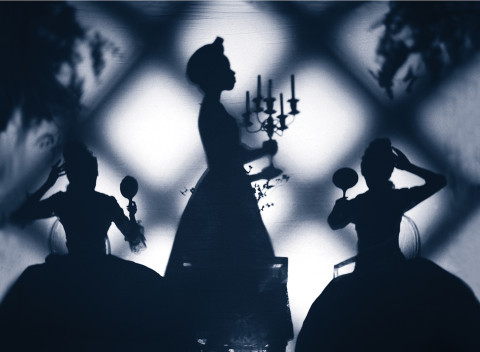Carrie Mae Weems, the preeminent photographer of the Black American experience, has long been celebrated for her poetic meditations on the nature of identity, history, and culture. Since her first major project in 1981, she has become known for her construction of fictional narratives with text as well as the frequent insertion of her own image into artwork, asserting the specificity of the Black female experience. Born in 1953 in Portland, Oregon, Weems left home at the age of sixteen for San Francisco, where she became a dancer and performer. She received a camera in her early twenties and a few years later attended California Institute of the Arts, earning her BFA in 1981, the same year she began her first major project, Family Pictures and Stories (1981–82). A multidisciplinary work, it features candid photographs of her own family at home accompanied by written captions and an audio recording. Weems attended UC San Diego, where she earned her MFA in 1984 and UC Berkeley where she obtained an MA in folklore in 1987, setting the stage for a prolific career comprising numerous series that explore a range of personal and cultural themes as well as those of a political nature.
With Ain't Jokin' (1987–88), Weems drew upon traditions of cutting Black humor and stinging stereotypes. Colored People (1989–90) explores the diverse tonal range of Black skin and its attendant popular meanings and interpretations. Also accompanied by text, The Kitchen Table (1990), one of Weems’s most famous series, pictures episodes in the life of a female protagonist (played by the artist) who sits at the titular site. From Here I Saw What Happened and I Cried (1995–96) also employs language to trace the long arc of the history of Black Americans through their fraught past in photography. And a more recent work, Slow Fade to Black (2010), features blurred portraits of once-feted Black female singers and performers whose legacies in popular culture have faded over time in contrast to their white counterparts.
The fading of cultural histories and shadowing of social structures inform the imagery of Weems’s 2003 video Meaning and Landscape. Originally conceived as part of the artist’s Louisiana Project—which was created for the commemoration of the bicentennial of the Louisiana Purchase (1803)—the work takes a critical look at the preservation of racial divisions and economic disparities in the region since the nineteenth century.
Set to the lush piano soundtrack “In a Landscape” by John Cage, the video opens with grainy black-and-white footage from a Rex Mardi Gras Ball. Founded in 1872, Rex is one of the oldest all-white, upper-class carnival Krewes (social organizations that stage parades during Mardi Gras) in New Orleans. It ends the festivities with an exclusive debutante ball. Accordingly, Weems shows a smiling couple parading through a ballroom with onlookers applauding them as they end with a bow to introduce the young woman into society. This tradition began in the antebellum era and the footage indeed appears antiquated but it in fact took place in 2003. It therefore indicates the perpetuation of not only nineteenth-century customs but also social hierarchies. However, the second part of Weems’s video addresses the pretense of those underlying structures that performances such as the Rex Ball serve to obfuscate.
In Meaning and Landscape, a series of vignettes feature silhouetted figures in nineteenth-century attire and a well-appointed interior. The shadow of a lattice-patterned wall is projected onto them, reinforcing the sense that they are out of public view. In this private setting, several scenes take place: A domestic servant intermittently strides across the screen with a candelabra, two women circle each other in a dance or perhaps a confrontation, and a man enters to inspect their appearance and choose one for a courtly dance. Soon after, another (or the same) woman appears for a different form of pleasure. She approaches him with a riding crop and smacks his hand, entices him with a seductive dance, and eventually rides him like an animal, smacking his buttocks as he crawls across the floor. Two women are later seated for tea service, during which they rock back and forth from laughter and groom themselves in handheld mirrors, seemingly oblivious to, or in denial of, the nefarious activities that occurred beneath their noses.
With all the players rendered as black silhouettes, their identities and locations are indistinct. Is this a home or a brothel? Are the characters Black, white, or both? Leaving such questions unanswered and appearances unclear was intentional for Weems. She admits she “thought it would be much more interesting to be able to pull back and to simply see these [interactions] in a shadow play where all the gestures are there but you don’t necessarily know who is in it.” Shrouded in darkness, conventions are disregarded, boundaries are crossed, and hierarchies are dismantled, negating the social order presented in the earlier Rex Ball footage. Weems thus posits an even more extreme, carnivalesque reversal of roles in grand homes of the past than that which occurs during Mardi Gras, with those on the bottom literally riding on top. While speculative, Meaning and Landscape nonetheless rings true, exposing the complex, intertwined nature of race and class in American society that is historic yet unseen, enduring yet disavowed. —Kanitra Fletcher

